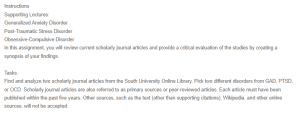Article Review – General Anxiety Disorder and Post-Traumatic Stress Disorder
General Anxiety Disorder
The study by Bishaw et al. (2022) was conducted to examine the prevalence and other prevailing factors connected to general anxiety disorder among pregnant women who sought antenatal care during the COVID-19 pandemic. This study was undertaken in public health institutions in the east Gojjam zone. The method used by Bishaw et al. (2022) was a cross-sectional study, and the researchers conducted the cross-sectional study between 1st to 30th December 2020. The study sampled 847 pregnant women using a random sampling technique. The findings of this study showed that the prevalence of anxiety disorder among these pregnant women during the Pandemic was 43.7%. This research concluded that there is a higher prevalence rate of generalized anxiety was very high among pregnant women during the COVID-19 pandemic (Bishaw et al., 2022). The researchers also identified risk factors such as the perception of COVID–19 and the negative attitude towards GAD.
This paper made three major points. Firstly, it reaffirmed that pregnant women and those in their gestational period experience GAD. Secondly, the paper emphasizes that GAD was an issue during the Pandemic (Bishaw et al., 2022). Thirdly, the paper also reaffirmed that GAD increased during the pandemic. These observations are correct, and they resonate with the information in the class texts that clearly show that women during pregnancy have increased levels of anxiety (Gabbard, 2014). The observations made in this paper also resonate with the ideas in the class texts that GAD, general anxiety, has a higher prevalence rate when there are disasters.
My opinion on this research is that it reaffirms the understanding that GAD is an issue among pregnant women and those undertaking gestational services. It is also important to connect this study’s findings to the Pandemic; thus, this study alerts experts in this area to undertake more studies on GAD and its connection to the Pandemic. The other observation is that this study helps uncover pandemics’ impacts on mental illnesses.
Post-traumatic Disorder
The study done by Louis et al. (2023) assessed the state of post-traumatic disorder among people after the Pandemic. Specifically, this study focused on post-traumatic stress disorder among COVID-19 patients. The research study employed a cross-sectional descriptive study conducted in Ismailia and the governorates of Suez between May and November 2020. The research sampled 200 male and female adult patients and 100 patients who had recent COVID-19 infections (Louis et al., 2023). The researchers identified the following outcomes after undertaking the study. From the 200 participants, the researchers found that 112 (56%) of the participants had PTSD (Louis et al., 2023). The study also uncovered that there was a connection between the Pandemic and post-traumatic stress disorder.
The researchers made the following points out of the study and the paper in general. The first point was that post-traumatic disorder is a disorder that emerges with any trauma, whereas illness can also be a trauma that leads to PTSD (Louis et al., 2023). The second point in the paper states that post-traumatic stress disorder follows traumatic events. The third point in the paper states that the PTD has a connection with the recent Pandemic. These main points in the paper resonate with the ideas discussed in the course this week because it is evident and true that PTSD is a mental illness that is connected mainly with traumatic experiences, where COVID-19 is one such trauma.
My opinion on the points covered in this research paper is that they are accurate, and other studies also support them. There is enough evidence to show that the pandemic led to post-traumatic stress disorder (Gabbard, 2014). This study thus opens up psychiatrists’ minds to the impacts that catastrophes like pandemics can have on people even post-pandemic. Also, this literature opens the minds of mental health experts to undertake further studies on PTSD post-COVID-19 and how it has impacted many other people in different ways.
References
Bishaw, K. A., Andalem, A., Amha, H., & Wondie, T. (2022). Generalized Anxiety Disorder and Its Associated Factors Among Pregnant Women During COVID-19 at Public Health Facilities of East Gojjam Zone, 2020: A Multi-Center Cross-Sectional Study. Frontiers in global women’s health, 3, 918332. https://doi.org/10.3389/fgwh.2022.918332
Gabbard, G. O. (2014). Gabbard’s Treatments of Psychiatric Disorders. United States: American Psychiatric Publishing.
Louis, N., Ragheb, M., Ibrahim, O., Salim, A., E Dean, Y., Kishk, R. M., Elsaid, N. M. A. B., Salem, A., Shah, J., Aiash, H., & Eida, M. (2023). Assessment of post-traumatic stress disorder and health-related quality of life among patients recovered from mild-to-moderate COVID-19 and their close contacts: A cross-sectional study. Medicine, 102(40), e35210. https://doi.org/10.1097/MD.0000000000035210
ORDER A PLAGIARISM-FREE PAPER HERE
We’ll write everything from scratch
Question 
Instructions
Supporting Lectures:
Generalized Anxiety Disorder
Post-Traumatic Stress Disorder
Obsessive-Compulsive Disorder
In this assignment, you will review current scholarly journal articles and provide a critical evaluation of the studies by creating a synopsis of your findings.

Article Review
Tasks:
Find and analyze two scholarly journal articles from the South University Online Library. Pick two different disorders from GAD, PTSD, or OCD. Scholarly journal articles are also referred to as primary sources or peer-reviewed articles. Each article must have been published within the past five years. Other sources, such as the text (other than supporting citations), Wikipedia, and other online sources, will not be accepted.